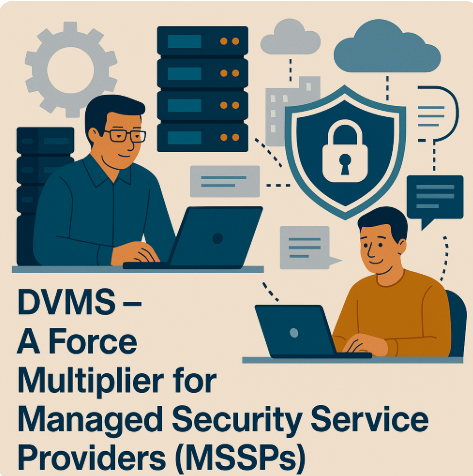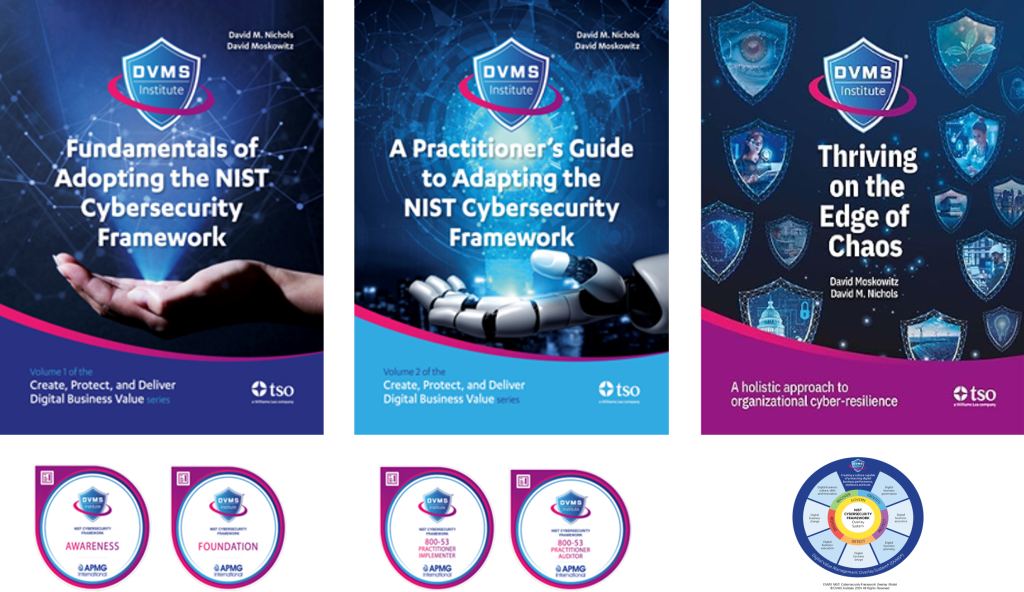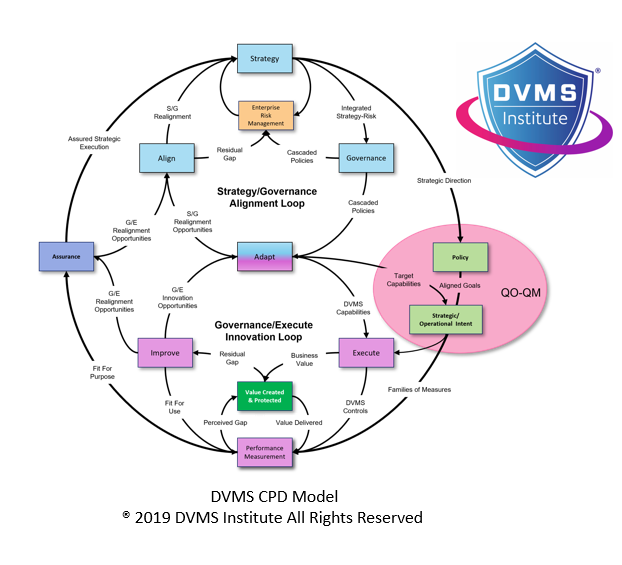The DVMS Institute’s NIST-CSF-DVMS Overlay System – A Force Multiplier for Managed Security Service Providers (MSSP’s)
Rick Lemieux – Co-Founder and Chief Product Officer of the DVMS Institute
Redefining Cybersecurity as a Strategic Business Function
In today’s rapidly evolving threat landscape, organizations face unprecedented cyber risks that threaten technical infrastructure and strategic business value. This complexity has propelled Managed Security Service Providers (MSSPs) into critical roles within enterprise ecosystems, acting as guardians of operational resilience and enablers of digital transformation.
Central to the advancement of MSSP capabilities is the NIST-CSF-DVMS, a strategic overlay system that fuses the National Institute of Standards and Technology Cybersecurity Framework (NIST CSF) 2.0 with the DVMS Institute’s Digital Value Management System (DVMS). This powerful integration empowers MSSPs to transcend traditional IT security paradigms and offer holistic, outcome-driven services centered around resilience and innovation.
Integrating Cybersecurity and Digital Value Delivery
At the core of this transformation is the recognition that cybersecurity must be more than a defensive IT function—it must be an intrinsic component of business value creation and preservation. The NIST-CSF-DVMS overlay provides MSSPs with an operational blueprint to achieve this shift. By harmonizing the CSF Core Functions—Govern, Identify, Protect, Detect, Respond, and Recover—with DVMS’s Create-Protect-Deliver (CPD) value model, MSSPs can manage digital value across their lifecycle. This integration allows them to frame their offerings regarding threat mitigation and as proactive contributors to enterprise governance, risk assurance, and strategic agility.
Addressing Complexity Across Client Environments
MSSPs serve clients across sectors with varying cybersecurity maturity levels, regulatory burdens, and risk appetites. The overlay system addresses this diversity by offering a scalable and adaptive model that aligns with existing organizational frameworks while exposing performance gaps. The DVMS overlay is not a static checklist, but a dynamic “system of systems” designed to evolve alongside organizational needs. By implementing the overlay, MSSPs can rapidly assess client cybersecurity postures, design tailored improvement roadmaps, and articulate their services regarding business value rather than just technical output. This capability is vital for clients operating in regulated environments, where resilience and governance are non-negotiable.
Aligning Cybersecurity with Business Strategy
Moreover, the NIST-CSF-DVMS framework facilitates the convergence of security operations with business imperatives. This alignment is crucial in a VUCA (volatile, uncertain, complex, ambiguous) world where cyber threats evolve faster than organizational hierarchies can respond. MSSPs, enabled by the overlay, can seamlessly integrate cybersecurity into business continuity planning, enterprise risk management, and digital transformation efforts. This shift allows MSSPs to become strategic partners, not just technical service vendors. Participating in digital governance and value assurance, they help organizations achieve true cyber operational resilience—defined not merely as surviving attacks but thriving amid disruption.
Operational Resilience as a Continuous Journey
The overlay system also redefines operational resilience as an ongoing, strategic pursuit rather than a reactive end-state. Through the DVMS ZX minimum viable capability model, MSSPs can help clients mature through structured capability levels—Govern, Assure, Plan, Design, Change, Execute, Innovate—ensuring their cybersecurity programs evolve with digital initiatives. By aligning with the NIST CSF Tiers (Partial to Adaptive), MSSPs provide a transparent lens into the organization’s cybersecurity maturity, enabling executive stakeholders to make informed risk-based decisions.
Integrating the 3D Knowledge Model for Strategic Coherence
A foundational component of the DVMS overlay that amplifies its value for MSSPs is the 3D Knowledge Model, which introduces a tri-dimensional approach to aligning strategic intent, team dynamics, and inter-departmental collaboration. In the complex and rapidly shifting cyber landscape, it is no longer sufficient for MSSPs to rely solely on technical defenses and regulatory compliance. To embed cyber resilience and foster innovation, MSSPs must understand and manage how knowledge flows across the organization and between clients, teams, and leadership.
The 3D Knowledge Model functions across three planes. First, strategic coherence ensures that cybersecurity initiatives are deeply aligned with business objectives. Rather than treating security as an afterthought or siloed function, this model embeds cybersecurity governance into the value creation process. MSSPs applying this model are equipped to guide their clients through articulating measurable business outcomes and the corresponding cyber strategies needed to achieve them.
Second, team-centric learning and execution promote the cultivation of high-performing, cross-functional teams within MSSP and client organizations. This dimension recognizes that team capabilities, motivation, and culture are integral to successful cybersecurity operations. MSSPs using the 3D Knowledge Model can structure engagements to encourage knowledge transfer, collaborative problem-solving, and adaptive response protocols that empower client teams over time.
Third, organizational integration addresses the systems-level challenge of aligning roles, responsibilities, and decision-making across departments. The 3D model enables MSSPs to break down operational silos by mapping interdependencies and communication channels within the client’s structure. This leads to more resilient governance and a shared understanding of the enterprise’s cyber risks and innovation opportunities.
When integrated into the NIST-CSF-DVMS overlay, the 3D Knowledge Model enables MSSPs to deliver technical services and a knowledge architecture that fosters sustainable resilience and innovation. It gives MSSPs the tools to operationalize cybersecurity as an enabler of digital transformation by aligning strategy, execution, and structure—three critical levers for navigating uncertainty and seizing opportunity in a VUCA world.
Driving Innovation Through Structured Models
Cyber resilience is no longer sufficient; business innovation is equally critical. The DVMS overlay embeds innovation into the MSSP operating model through its “Innovate” capability. MSSPs are encouraged to explore four types of innovation: incremental, sustaining, adaptive, and disruptive. By using structured methodologies like Goal-Question-Metric (GQM) and Question-Outcome-Question-Metric (QO-QM), they can drive evidence-based and strategically aligned innovation. This ensures that innovation initiatives are not disconnected side projects, but integrated elements of service evolution and client value delivery. Through innovation, MSSPs can differentiate their offerings, anticipate market shifts, and co-create new digital capabilities with clients.
Cultural Agility and Leadership as Enablers
The overlay also recognizes that cultural agility and leadership accountability are vital enablers of resilience and innovation. It promotes the development of learning organizations where transparency, adaptability, and risk-informed decision-making are cultural norms. MSSPs trained in the DVMS approach are not just technology implementers—they are facilitators of cultural transformation within client environments. They help embed cyber governance and operational resilience into organizational DNA, enabling clients to self-sustain progress long after an engagement ends.
Economic Efficiency and Scalability
Economically, the framework enhances the business case for MSSP engagement. Many small and mid-sized enterprises struggle to justify the costs of in-house cybersecurity teams with 24/7 coverage, AI-driven analytics, and incident response capabilities. MSSPs can offer these services at scale with predictable pricing models, reducing clients’ financial and operational burdens. By following the NIST-CSF-DVMS model, MSSPs can optimize resource allocation, deliver services aligned with client risk profiles, and ensure accountability through defined metrics and continuous improvement loops.
Meeting Sector-Specific Requirements
Sector-specific needs further reinforce the value of the overlay approach. Industries such as healthcare, finance, utilities, and government, where cyber resilience is often a matter of national interest, benefit from MSSP capabilities that align with regulatory mandates and evolving threat vectors. By incorporating Operational Technology (OT) and Internet of Things (IoT) security into their portfolios, MSSPs can deliver comprehensive services encompassing the full enterprise risk spectrum. The DVMS overlay enables this breadth by providing a unifying system that contextualizes security operations within broader digital and governance architectures.
Enabling Strategic Transformation for MSSPs
Ultimately, the NIST-CSF-DVMS overlay transforms MSSPs from transactional service providers into strategic enablers of business resilience and digital innovation. By combining proven cybersecurity frameworks with systems thinking, cultural agility, and outcome-based methodologies, MSSPs can elevate their role in client organizations. They deliver not just protection but assurance, not just detection but strategic foresight, not just compliance but transformative innovation.
The NIST-CSF-DVMS – The Force-Multiplier for MSSPs
As digital threats become more sophisticated and the pace of business accelerates, the need for integrated, agile, and value-centric cybersecurity solutions will only grow. MSSPs who embrace the NIST-CSF-DVMS model will meet this need and lead the next evolution of managed cybersecurity services. In doing so, they enable their clients to thrive at the edge of chaos, where resilience and innovation are the currencies of long-term success.
About the Author

Rick Lemieux
Co-Founder and Chief Product Officer of the DVMS Institute
Rick has 40+ years of passion and experience creating solutions to give organizations a competitive edge in their service markets. In 2015, Rick was identified as one of the top five IT Entrepreneurs in the State of Rhode Island by the TECH 10 awards for developing innovative training and mentoring solutions for boards, senior executives, and operational stakeholders.
In today’s digitally driven economy, cyber disruptions are no longer an “if” but a “when.”
The DVMS Institute’s Certified Training Programs teach organizations the skills to build and operate a Holistic, Adaptive, and Culture Aligned System capable of coordinating Cyber Resilience actions across an enterprise’s Digital Supply Chain.
True cyber resilience requires the seamless alignment of Strategy, Governance, and Operations (SGO) across the enterprise digital supply chain, supported by a Leadership Team and culture committed to creating, protecting, and sustaining resilient digital value.
The DVMS training programs position cyber resilience not as a technical function but as a strategic, supply-chain-wide organizational capability.
This systems-based approach, powered by the DVMS CPD, Z-X, 3D Knowledge models, supported by a Culture that mandates engagement from Leadership, Employees, and Supply Chain partners, each fulfilling distinct responsibilities to enable cyber resilience.
This adaptive, forward-looking approach to Governance, Resilience, and Assurance (GRA) positions your business to:
- Maintain Operational Stability Amidst Constant Digital Disruption
- Drive Agility and Trust Across Your Digital Ecosystem
- Satisfy Critical Regulatory and Certification Requirements (SEC, NIS2, DORA, etc.)
- Leverage Cyber Resilience as a Competitive Advantage
DVMS Module Explainer Videos
- DVMS Architecture Video: David Moskowitz explains the DVMS System
- DVMS Case Study Video: Dr. Joseph Baugh Shares His DVMS Story.
- Overlay Model – Using existing systems to power operational resilience
- ZX Model – The business capabilities that power operational resilience
- CPD Model – Adaptable governance & assurance across the enterprise
- 3D Knowledge Model – Enabling holistic organizational learning
- FastTrack Model – A phased approach to adapting a NIST-CSF-DVMS
Digital Value Management System® is a registered trademark of the DVMS Institute LLC.
® DVMS Institute 2025 All Rights Reserved





